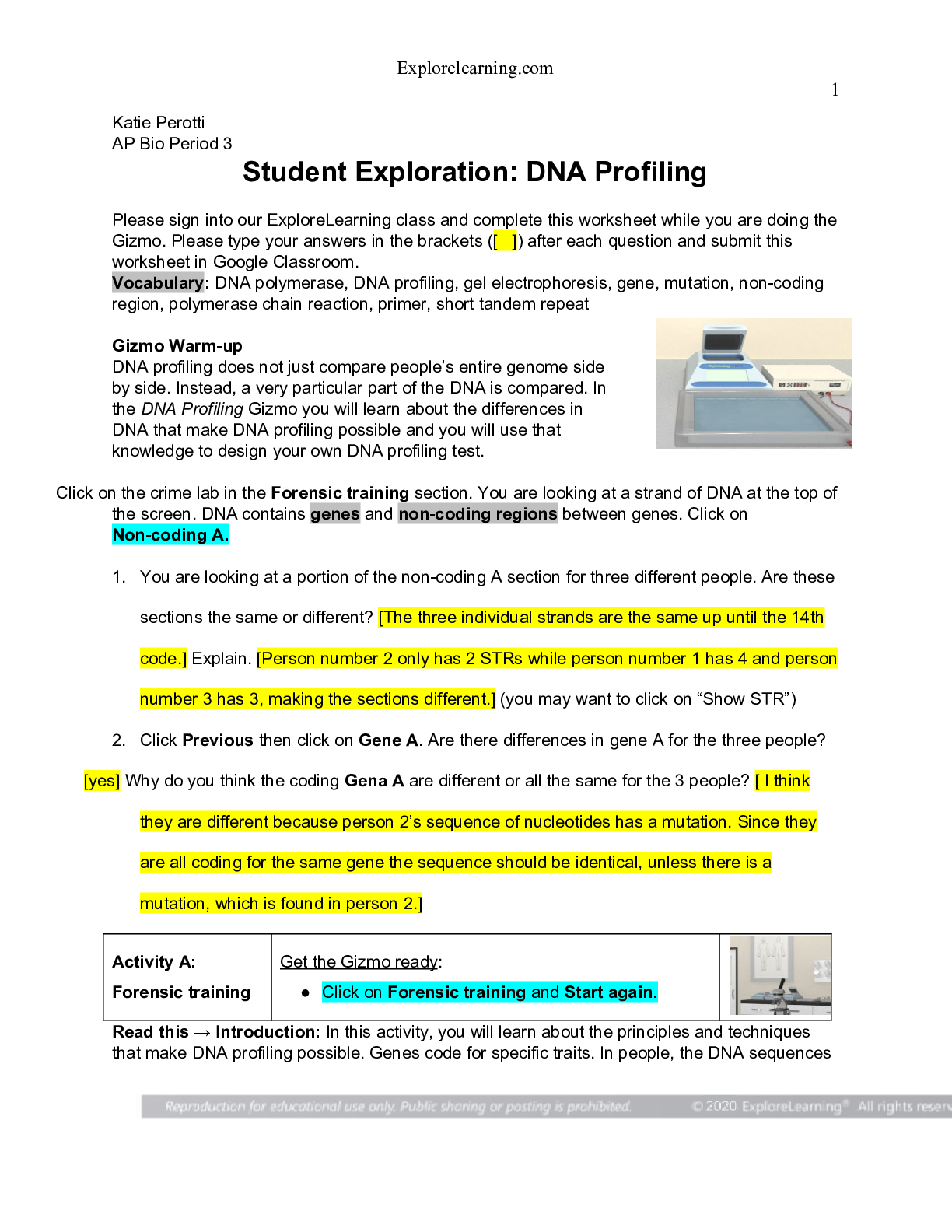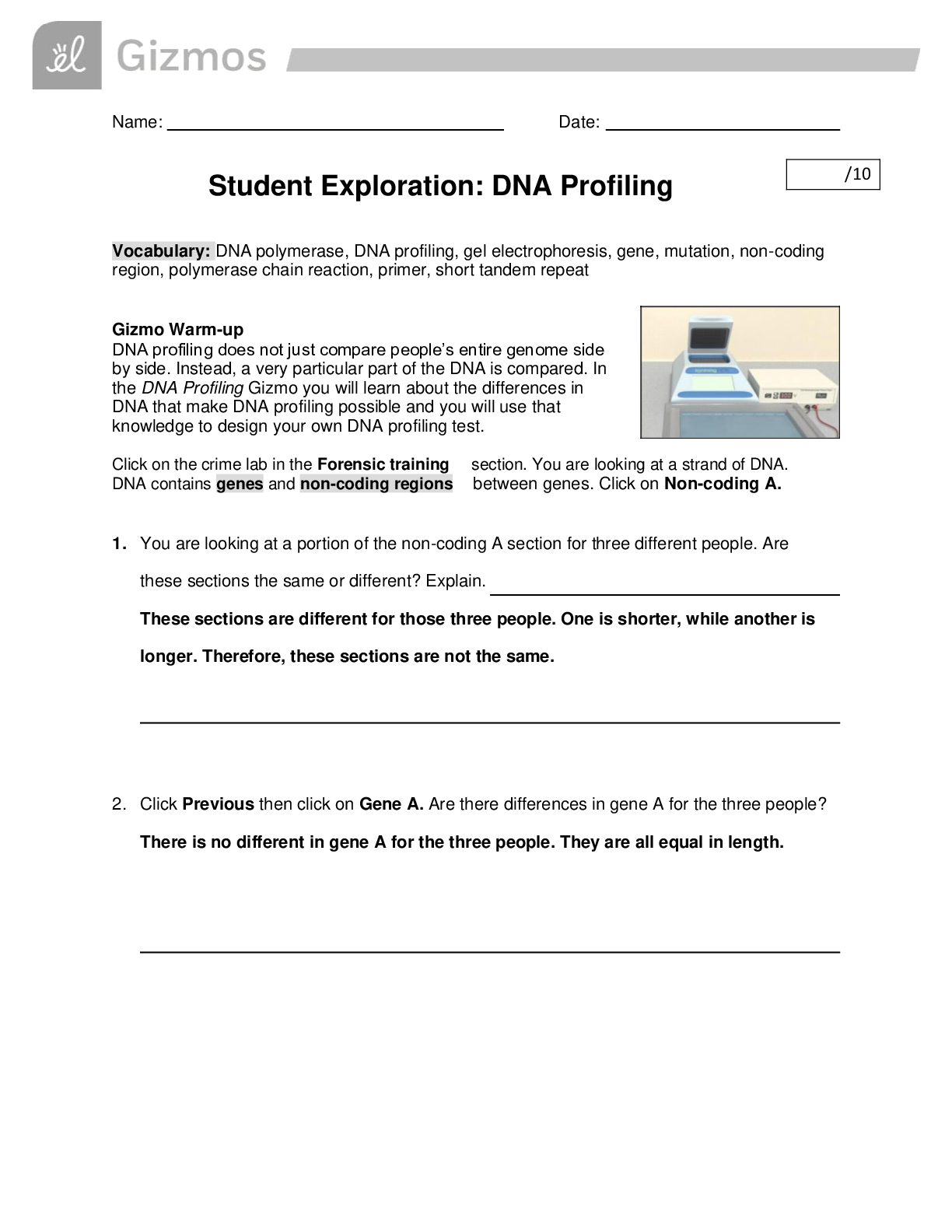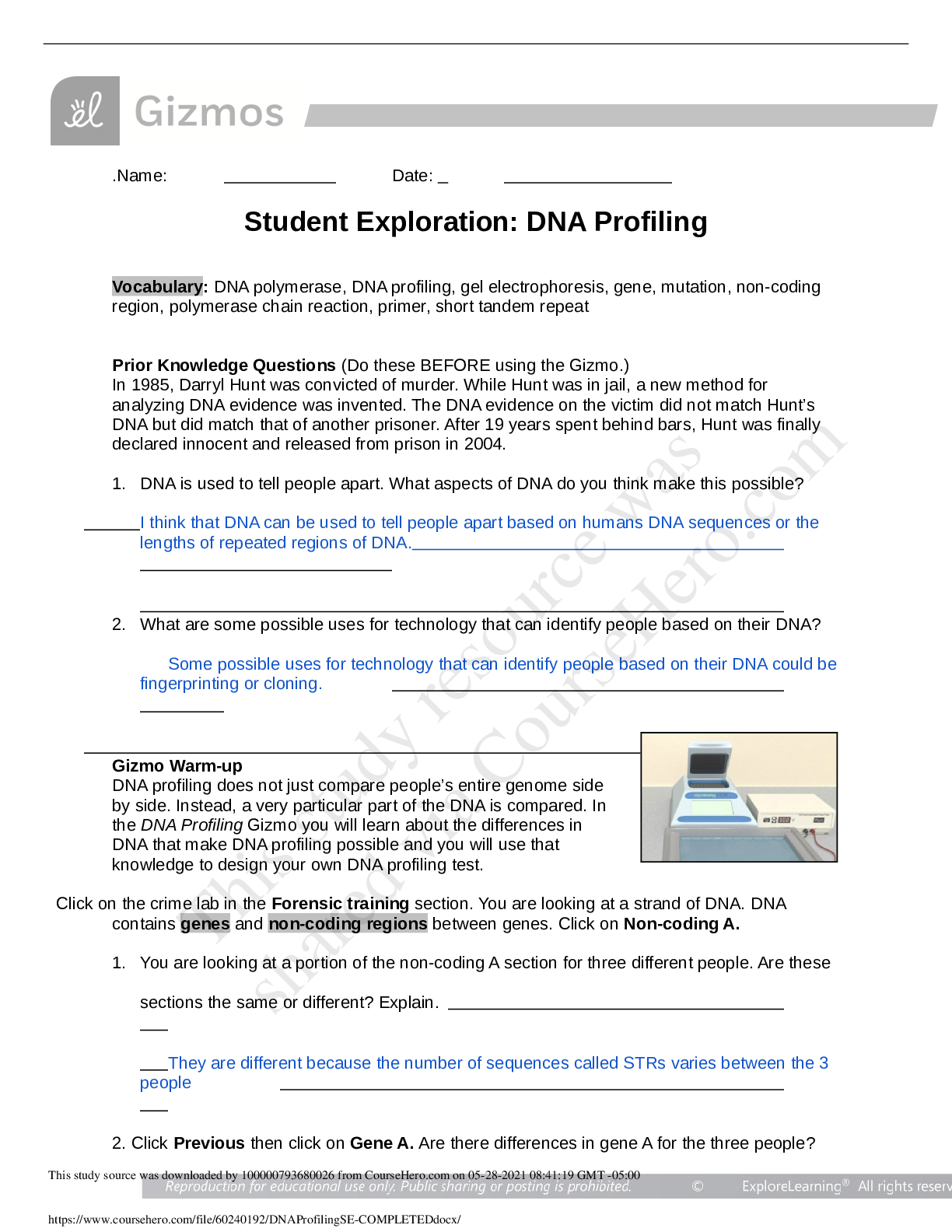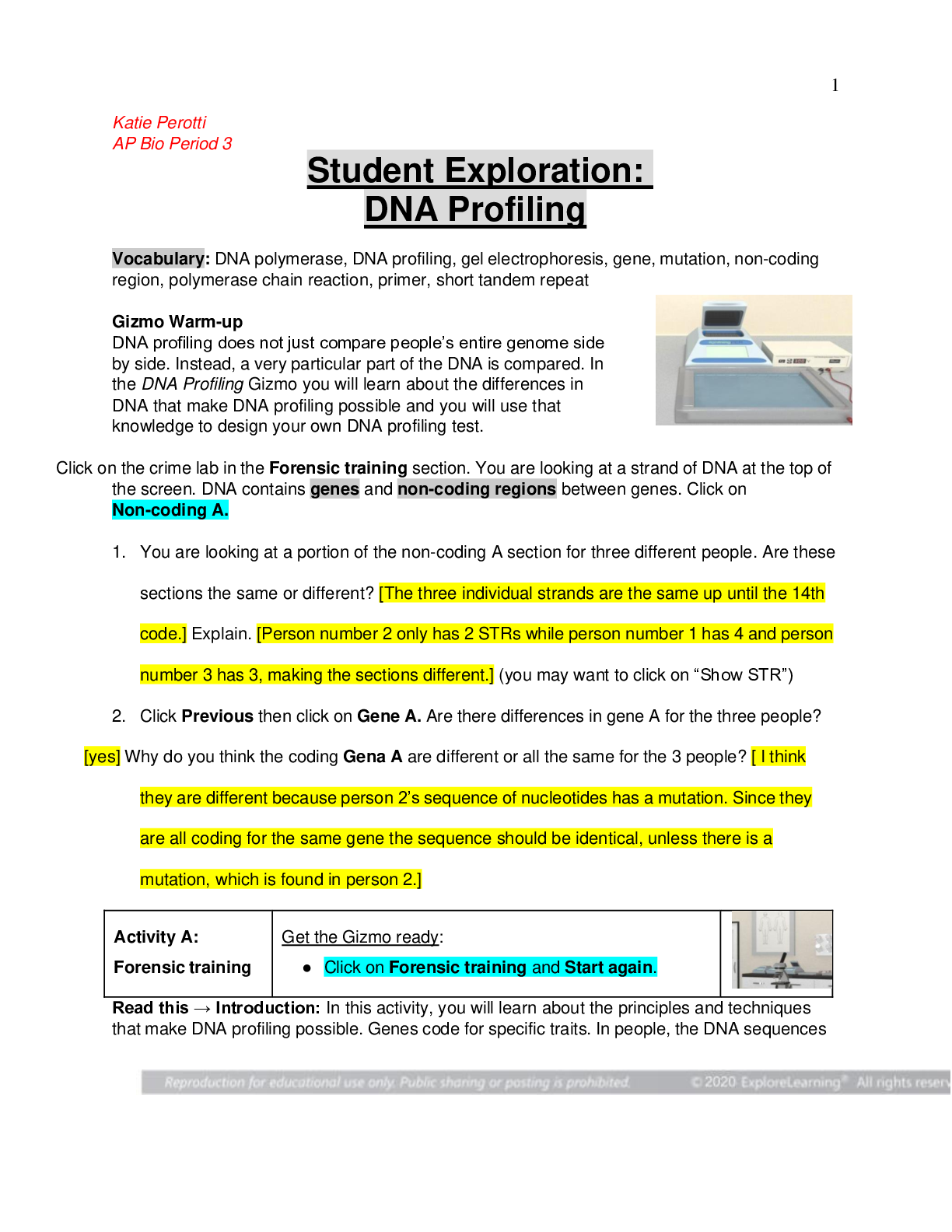student Exploration DNA Profiling
Document Content and Description Below
student Exploration DNA Profiling Student Exploration: DNA Profiling Please sign into our Explore Learning class and complete this worksheet while you are doing the Gizmo. Please type your answers... in the brackets ([ ]) after each question and submit this worksheet in Google Classroom. Vocabulary: DNA polymerase, DNA profiling, gel electrophoresis, gene, mutation, non-coding region, polymerase chain reaction, primer, short tandem repeat Gizmo Warm-up DNA profiling does not just compare people’s entire genome side by side. Instead, a very particular part of the DNA is compared. In the DNA Profiling Gizmo you will learn about the differences in DNA that make DNA profiling possible and you will use that knowledge to design your own DNA profiling test. Click on the crime lab in the Forensic training section. You are looking at a strand of DNA at the top of the screen. DNA contains genes and non-coding regions between genes. Click on Non-coding A. 1. You are looking at a portion of the non-coding A section for three different people. Are these sections the same or different? [The three individual strands are the same up until the 14th code.] Explain. [Person number 2 only has 2 STRs while person number 1 has 4 and person number 3 has 3, making the sections different.] (you may want to click on “Show STR”) 2. Click Previous then click on Gene A. Are there differences in gene A for the three people? [yes] Why do you think the coding Gena A are different or all the same for the 3 people? [ I think they are different because person 2’s sequence of nucleotides has a mutation. Since they are all coding for the same gene the sequence should be identical, unless there is a mutation, which is found in person 2.] Activity A: Forensic training Get the Gizmo ready: ● Click on Forensic training and Start again. Read this → Introduction: In this activity, you will learn about the principles and techniques that make DNA profiling possible. Genes code for specific traits. In people, the DNA sequencesAP Biology Unit 6 Page 2 for most genes are nearly identical, since any change could result in a harmful disorder. The areas between genes do not code for any essential traits, so a change to the DNA sequence doesn’t have any major consequences. As a result, these regions tend to be very different for different people. Question: How can the differences in DNA be exploited to perform DNA profiling? 1. Observe: Click on non-coding A. What do you see in the middle of each of the three DNA sequences? [ ] 2. Compare: Turn on Show short tandem repeats (STRs). An STR is a short, repeated sequence of DNA, like TAAA. They can be repeated any number of times without affecting the traits of the person. Different people usually have different numbers of repeats. What does this do to the length of each person’s non-coding regions? [ ] 3. Create: Your goal is to make copies of the STR region. To do this, you will make primers that surround the STR region. A primer is a short sequence of DNA that acts as a starting point for DNA replication. Click Next. Click on person 1’s DNA to separate the two strands. Drag along the AAGGC nucleotides, and then the TCGCC nucleotides to create primers. Click Next. The Gizmo will add the same primers to the two other people. What do you notice about where the primers attach in each person? [ ] Why do you have to drag each strands in opposite directions to add the primers? [ ] 4. Observe: Click Next. An enzyme called DNA polymerase uses the primers as a starting point to copy the DNA. Copying DNA using primers is a technique called Polymerase chain reaction (PCR). Click Next again. The DNA segments are copied millions of times. What do you notice about the lengths of the copied DNA strands? [ ] 5. Compare: Click Next. Gel electrophoresis is used to separate DNA strands of different lengths. An electric current is passed through the gel. As the current moves from top to bottom, it pulls the DNA and loading dye along with it. Click on the power box to turn it on. Please take a screen shot and paste here ↓ A. Which person’s DNA band traveled the farthest? [ ] Shortest? [ ] Turn on Show labels. What do you notice about the length of the DNA versus the distance it traveled down the gel? [ ] Please take a screen shot and paste here ↓ B. Can you identify people by comparing the length of STR regions on a gel? [ ] Explain. [ ] 6. Observe: Click Next. Then select Gene A. A. Does gene A have any STRs? [ ] Why or why not? [ ]AP Biology Unit 6 Page 3 B. Are there any differences in gene A between the individuals? [ ] Genes may contain small mutations that don’t affect the length of the segment. C. Create primers and copy the DNA. What do you notice about the length of the duplicated regions? [ ] D. Click Next and turn on the gel electrophoresis apparatus. What do you notice about the position of the band? [ ] E. Can you identify people by comparing the length of genes on a gel? [ ] Explain. [ ] 7. Summarize: In your own words, how can PCR and gel electrophoresis be used to identify people? [ ] Activity B: Design and test primers Get the Gizmo ready: ● Select Design primers on the left. Introduction: To identify people based on DNA, copies of certain segments of DNA are compared using gel electrophoresis. In this activity, you will design primers that will copy segments of DNA that will help to identify people. Question: How can you use your knowledge to create a DNA profiling test? 1. Predict: Gel electrophoresis distinguishes DNA segments by length. To identify people by DNA, is it better to make copies of genes or non-coding segments? [ ] Explain. [ ] 2. Create: Pick a section of DNA you want to copy and follow the directions to create primers. A. Click Preview primer. Did the DNA copy properly? [ ] B. Do you get segments of DNA that are different lengths for each person? [ ] Click Save primer when you are satisfied. Create more primers using other parts of the chromosome. Be sure each primer set copies DNA segments that vary in length. Please take a screen shot and paste here → 3. Test: Switch to the Test primers section. DNA was isolated from the skin and blood of four different people. Select the primers you created (now in the saved primers section) then click Run analysis to run the PCR and gel electrophoresis tests on the samples. You will notice that each primer creates two bands on the gel, because each person has two copies of each chromosome. ● Based on the test, [Show More]
Last updated: 1 year ago
Preview 1 out of 7 pages

Reviews( 0 )
Document information
Connected school, study & course
About the document
Uploaded On
Feb 09, 2023
Number of pages
7
Written in
Additional information
This document has been written for:
Uploaded
Feb 09, 2023
Downloads
0
Views
56












